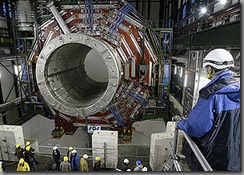
First major CERN test complete, scientists cheer
Associated Press
 The world's largest particle collider successfully completed its first major test by firing a beam of protons all the way around a 17-mile (27-kilometre) tunnel on Wednesday in what scientists hope is the next great step to understanding the makeup of the universe.
The world's largest particle collider successfully completed its first major test by firing a beam of protons all the way around a 17-mile (27-kilometre) tunnel on Wednesday in what scientists hope is the next great step to understanding the makeup of the universe.
After a series of trial runs, two white dots flashed on a computer screen at 10:36 a.m. (0836 GMT) indicating that the protons had travelled the full length of the 3.8 billion US dollar Large Hadron Collider.
Cheers erupted from the assembled scientists, including project leader Lyn Evans, in the collider's control room at the Swiss-French border when the beam completed its lap.
Champagne corks popped in labs as far away as Chicago, where contributing scientists watched the proceedings by satellite.
Physicists around the world now have much greater power than ever before to smash the components of atoms together in attempts to see how they are made.
The European Organisation for Nuclear Research, known as CERN began firing the protons - a type of subatomic particle - around the tunnel in stages less than an hour earlier.
Now that the beam has been successfully tested in clockwise direction, CERN plans to send it counterclockwise.
Eventually two beams will be fired in opposite directions with the aim of recreating conditions a split second after the big bang, which scientists theorise was the massive explosion that created the universe.
The start of the collider - described as the biggest physics experiment in history - comes over the objections of some skeptics who fear the collision of protons could eventually imperil the earth.
The skeptics theorised that a byproduct of the collisions could be micro black holes, subatomic versions of collapsed stars whose gravity is so strong they can suck in planets and other stars.
James Gillies, chief spokesman for CERN dismissed this as nonsense before Wednesday's start.
CERN is backed by leading scientists like Britain's Stephen Hawking in dismissing the fears and declaring the experiments to be absolutely safe.
Gillies said that the most dangerous thing that could happen would be if a beam at full power were to go out of control, and that would only damage the accelerator itself and burrow into the rock around the tunnel.
Nothing of the sort occurred on Wednesday, though accelerator is still probably a year away from full power. The project organised by the 20 European member nations of CERN has attracted researchers from 80 nations.
Some 1,200 are from the United States, an observer country which contributed 531 million US dollar. Japan, another observer, also is a major contributor.
The collider is designed to push the proton beam close to the speed of light, whizzing 11,000 times a second around the tunnel.
Smaller colliders have been used for decades to study the makeup of the atom. Less than 100 years ago scientists thought protons and neutrons were the smallest components of an atom's nucleus, but in stages since then experiments have shown they were made of still smaller quarks and gluons and that there were other forces and particles.
The CERN experiments could reveal more about "dark matter," antimatter and possibly hidden dimensions of space and time.
It could also find evidence of the hypothetical particle - the Higgs boson - believed to give mass to all other particles, and thus to matter that makes up the universe.
